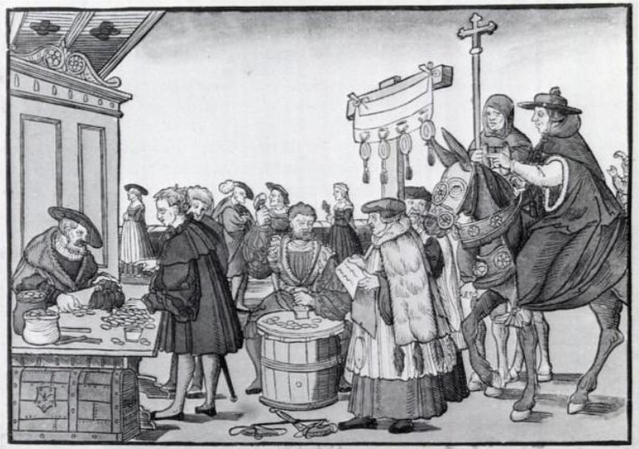Environment
Eco-Indulgences for Eco-Sin?
Are carbon offsets doing more harm than good?
Posted March 28, 2016

In medieval Europe many Catholics bought indulgences to reduce punishment for their sins and time in Purgatory. But the system of indulgences got out of hand—they proliferated wildly in a surge of corruption and were sold willy-nilly as a fund raising method for the Church, to fund cathedral construction, for instance. For many parishioners indulgences became a way to excuse and sustain their sinful ways, to alleviate their guilt and remorse.
Today, in the context of global climate change, it could be argued that a whole new category of sin has emerged: climate sin. And a parallel to Catholic indulges has likewise come forth: carbon offsets, which can be purchased to compensate for a person’s or organization’s climate change impact.
As I have mentioned in previous posts, global climate change is already inflicting serious harm including as many as half a million premature deaths per year through increased disease, crop losses due to drought and flooding, infection of water supplies through flooding, and so on.[1] So when we choose actions that contribute to climate change—eating meat, getting on a plane, driving—aren’t we somehow guilty of climate sin?
The supposed purpose of carbon offsets is to compensate for your climate change impact—say from purchasing an airline ticket—through projects such as renewable energy investments, the planting of forests that can absorb carbon dioxide from the atmosphere, or the capture methane from landfills. Carbon offsets are available for any climate change impact in your life from individual acts of flying and driving all the way up to the entire climate change impact of your life, which one offset site helps you calculate.[2]
![By Neutronic at English Wikipedia [Public domain], via Wikimedia Commons By Neutronic at English Wikipedia [Public domain], via Wikimedia Commons](https://cdn.psychologytoday.com/sites/default/files/styles/article-inline-half/public/field_blog_entry_images/256px-Turbine_aalborg.jpg?itok=r3DkJLB8)
The parallels between medieval indulgences and carbon offsets opens up two important questions: Do carbon offsets do more than merely alleviate consumer guilt over climate change contributions—are they effective at actually mitigating climate change? And, more important, by alleviating consumer guilt, do they lead people to emit more greenhouse gases in the long run, by for instance making them feel better about then taking another flight, buying a bigger car, or building a larger house, just as Catholic indulgences made some people feel free to keep on sinning?
Rebound to Backfire
I’ll get to the first question in a minute, but the second question is intriguing from a psychological perspective. As I’ve written in a previous post, the rebound effect (aka the Jevons Paradox) takes place when a new development, such as a more efficient car, which has the potential to reduce resource consumption, instead ends up causing greater resource use. A 19th-century British economist, William Stanley Jevons, observed that technologies that increased the efficiency of coal use, such as better steam engines, led to greater use of such technologies and thus greater consumption of coal—just the opposite of what you might intuitively expect. Rebound occurs when some of the added efficiency is negated by greater use; backfire occurs when all of the added efficiency is negated, and then some.
A study published in the Journal of Consumer Psychology experimentally verified the rebound effect. When the possibility of recycling paper was offered in an experimental setting, people consumed more paper.[3]
How does rebound work? The presence of the recycling option may pre-emptively alleviate any guilt or other negative emotions associated with taking and using the paper. Or we may keep a kind of karmic balance sheet in our heads in which one positive action excuses a negative one. For instance I know that when I’ve exercised a lot or eaten particularly healthily, I often then feel like I can then commit food sin. Hello, donut!
But does purchasing carbon offsets backfire—does it lead to overall greater global climate change? In other words is it counterproductive?

Multiple studies including the one mentioned above on recycling demonstrate rebound or backfire in the case of environmental decision making. To see whether rebound is at work when carbon offsets are purchased was the goal of the study, "Do voluntary carbon offsets induce energy rebound? A conservationist’s dilemma." The authors found that it does indeed, though the rebound they found appears to be quite small, in the neighbhorhood of 1–3%.[4] Other analyses are even less optimistic for carbon offsets. One article in the Christian Science Monitor casts a lot of doubt of the reliability of purchased offsets, and another, “The inconvenient truth of carbon offsets,” by climate scientist Kevin Anderson in the prestigious journal Nature concludes, “Offsetting is worse than doing nothing. It is without scientific legitimacy, is dangerously misleading and almost certainly contributes to a net increase in the absolute rate of global emissions growth.” Anderson writes, “any claim to offset my emissions must, with a reasonable level of certainty and for a 100-year period, show that the flight emissions plus any emission consequences of the offset projects ultimately sum to zero. It is the immutable impossibility of making such long-term assurances that fundamentally challenges the value of such a claim.”
It seems likely that carbon offsets indeed lead to greater carbon impact for people and companies who use them as a way to justify maintaining the same lifestyle and choices as before.
Reduce!
One way to avoid this fate, to avoid creating more climate change by buying offsets, is to be very careful to ensure that you are reducing your climate change impacts (whether you are a corporate manager making decisions for your company or an individual making decisions for you and your family). You can then apply carbon offsets to your remaining climate impacts—the ones that are difficult or perhaps impossible to eliminate such as basic home heating and clothing.
Using this tandem approach of reduce and offset helps avoid rebound and backfire.
What does reduce look like? Eating less meat, flying less, driving less, purchasing less stuff you don’t need (because basically all manufacturing incurs a significant climate impact). The order that I list these items is important. For many people eating less meat and flying less are the primary ways that they can reduce their global climate change emissions. Some studies have found that animal agriculture—the production of all the meat and dairy we eat—contributes more than all transportation to global climate change through land use changes and all the gases cattle and other livestock emit. For instance, one study by the Food and Agriculture Organization of the United Nations estimates that livestock alone emit 18% (or 14.5% according to this study) of global greenhouse gas emissions. Another study by Robert Goodland and Jeff Anhang, researchers employed by the World Bank and International Finance Corporation (not the FAO, with its strong ties to the global livestock industry) puts the number at a whopping 51%--meaning most climate change is created by the livestock industry. That’s a lot of cow burps and forest destruction.
Reduction is the most reliable way of reducing your climate impact. You are almost entirely in control of the amount that you consume.
And what does offsetting look like? Well, it turns out that is not as simple as you might like, and this is another reason to look at offsets with a wary eye. Some carbon offset schemes have great potential and are almost certainly helping mitigate climate change, yet some have been downright failures. Certain schemes fund renewable energy projects in developed or developing economies, helping drive the shift away from burning fossil fuels. These are probably among the most helpful. Others, such as reforestation programs, have mixed results, particularly since there’s no solid guarantee that a forest won’t burn down or be clearcut in a decade or two, and the ability of trees to capture carbon fluctuates over their lifespans. But afforestation is in general a good thing in most circumstances.

Moreover, choosing a company from which to purchase carbon offsets takes some homework, since they all invest in different types of programs and have differing levels of credibility and reliability. Some certification programs have appeared that help make the choice of carbon offset companies easier. A predominant one is Green-e: http://www.green-e.org/getcert_ghg_products.shtml. Also check the Natural Resources Defense Council’s roundup of carbon offsets for more information on shopping for offsets.
Finally, if you’re serious about being out front in the coming great shift toward climate stabilization, look beyond what you can do with your own practices and look at the power of acting together. As I have written before, sustainability needs community. And climate stabilization needs deep-seated changes to our economy that must be accomplished through political action, for instance fighting for a “fee and dividend” system in which all carbon-emitting activities incur an additional cost, and the proceeds are distributed evenly to all members of society. Join together with others in your community and around the world by joining organizations such as 350.org and Citizens Climate Lobby to lead the way.
Bottom line: Reduction is your most dependable way of mitigating the climate impacts of your own life. After reducing where you can, go ahead and purchase offsets after doing some homework to choose the most reliable ones and those that match your own values. Follow the motto, “Reduce what you can, offset what you can’t.” Finally, transcend individualism and get together with others to demand systemic changes to our economy to transition to a healthier, more sustainable world that won’t leave climate chaos for future generations.
Learn about my book: Invisible Nature
Follow me: Twitter or Facebook
Read more of my posts: The Green Mind
[1] http://www.scientificamerican.com/article/twelve-diseases-climate-chang… https://news.vice.com/article/climate-change-is-helping-to-spread-deadl… http://www.newsweek.com/climate-change-ebola-outbreak-globalization-inf… http://ecowatch.com/2014/08/14/ebola-climate-change-connected/ https://www.washingtonpost.com/news/capital-weather-gang/wp/2014/08/05/…
[2] http://www.nativeenergy.com/carbon-calculators.html
[3] Jesse R. Catlin and Yitong Wang, “Recycling gone bad: When the option to recycle increases resource consumption,” Journal of Consumer Psychology 23, 1 (2013) 122–127.
[4] Harding, M., & Rapson, D. (2013). Do Voluntary Carbon Offsets Induce Energy Rebound? A Conservationist’s Dilemma.Journal of the Association of Environmental and Resource Economists. Retrieved from http://people.duke.edu/~mch55/resources/Harding_CS.pdf
Note: For more information on animal agriculture and climate change, I recommend this site.




